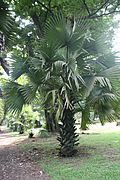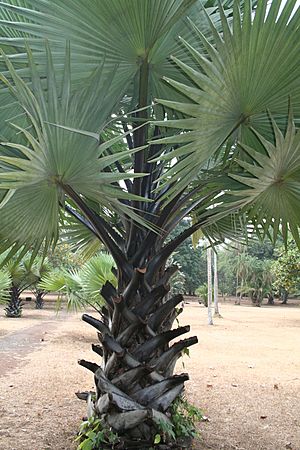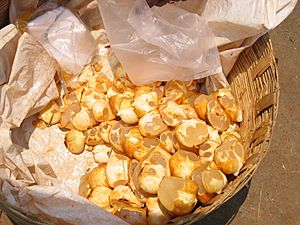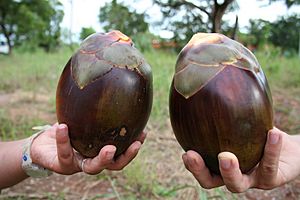Palmyra palm facts for kids
Quick facts for kids Palmyra palm |
|
|---|---|
 |
|
| Borassus flabellifer in Karainagar, Sri Lanka | |
| Scientific classification |
|
| Kingdom: | Plantae |
| Clade: | Tracheophytes |
| Clade: | Angiosperms |
| Clade: | Monocots |
| Clade: | Commelinids |
| Order: | Arecales |
| Family: | Arecaceae |
| Subfamily: | Coryphoideae |
| Tribe: | Borasseae |
| Genus: | Borassus L. |
| Type species | |
| Borassus flabellifer |
|
| Species | |
|
See text |
|
| Synonyms | |
|
|
The palmyra palm (scientific name: Borassus) is a group of five types of palm trees. These trees are known for their large, fan-shaped leaves. You can find them growing naturally in warm, tropical parts of Africa, Asia, and Papua New Guinea.
Contents
What are Palmyra Palms Like?
These huge palm trees can grow very tall, up to 30 meters (about 100 feet) high. Their trunks are strong and have clear marks from old leaves. Some types of palmyra palms have a noticeable bulge on their trunk just below the top. We don't know exactly why this happens.
The leaves look like big fans and can be 2 to 3 meters (6 to 10 feet) long. They have sharp spines along their edges, except for one type called B. heineanus. The base of the leaf has a special split where the flowers grow out. Old leaf bases stay on the trunk for a while before falling off.
All palmyra palms have separate male and female plants. This means that male flowers grow on one tree, and female flowers grow on a different tree. The male flowers are tiny, less than 1 centimeter long. They grow in small groups, tucked between tough leaf-like parts on hanging stalks. Female flowers are larger, about 3 to 5 centimeters wide, and are round. They sit directly on the flower stalk.
The fruits are round and measure about 15 to 25 centimeters (6 to 10 inches) across. Each fruit usually has 1 to 3 large seeds inside. The color of the fruit can be black, brown, yellow, or orange, depending on the type of palm. The soft, stringy inside of the fruit smells nice and tastes sweet. Each seed is protected by a hard, woody shell. This shell helps keep the seed safe when animals like elephants or monkeys eat the fruit.
When a palmyra seed starts to grow, the young plant first grows downwards into the soil. Only a few leaves appear above the ground. This helps protect the young plant from frequent fires that happen in its natural savanna home. After many years, the plant finally grows a strong stem and quickly gets taller than the savanna plants. At this point, it is much safer from fires.
Different Kinds of Palmyra Palms
There are five main types of palmyra palms. Each one grows in different parts of the world and has its own special features.
| Image | Fruits | Common Name | Scientific name | Native Distribution |
|---|---|---|---|---|
 |
 |
African palmyra palm, Rônier | Borassus aethiopum | tropical Africa & Madagascar |
 |
 |
Ake Assi's palmyra palm | Borassus akeassii | West and Central Africa |
 |
 |
Asian palmyra palm/lontar palm/doub palm | Borassus flabellifer | southern Asia from India to Indonesia |
| Papua New Guinea palmyra palm | Borassus heineanus | Papua New Guinea | ||
| Madagascar palmyra palm | Borassus madagascariensis | Madagascar |
Amazing Uses of Palmyra Palms

Palmyra palms are very useful and important for people, especially in South Asia and Southeast Asia. In countries like Cambodia and India, the palmyra palm has been one of the most important trees for a long time. It has over 800 different uses!
People use the strong leaves to make roofs, mats, baskets, fans, hats, and umbrellas. They also used to write on them.
In Sri Lanka, these palms are very common in the northern areas. Here, people use them to make a type of unrefined sugar called jaggery from the tree's sweet sap.
In Cambodia, the palmyra tree is a national symbol. You can often see these trees growing around famous places like Angkor Wat. Palmyra palms can live for more than 100 years.
Long ago in India, people used palmyra leaves as paper for writing. The natural lines in the leaves helped them write neatly. To prepare the leaves, they would boil them in salt water with turmeric powder to keep them from spoiling. Once dry, they polished the leaves with a rough stone, cut them to size, and made a hole in one corner. Each leaf could have four "pages." Writers used a special pointed tool called a stylus to scratch words onto the leaves. The writing style was often cursive, with letters connected. After writing, the finished leaves were tied together in bundles.
The wood from the palmyra palm is black, very hard, heavy, and lasts a long time. Because it's so strong, it's highly valued for building things. It's especially good for structures that are exposed to water, like docks, fences, and boats.

The palmyra tree also provides many types of food. Young palmyra plants can be cooked like a vegetable. They can also be roasted and then crushed to make a kind of flour. The ripe fruits are eaten roasted or raw. The young, clear, jelly-like seeds inside the fruit are also eaten.
A sweet sap, called toddy, can be collected from the young flower stalks of both male and female trees. This toddy can be fermented to make an alcoholic drink called arrack. It can also be boiled down to create a type of raw sugar known as jaggery or palm sugar. In Indonesia, this sugar is called Gula Jawa (Javanese sugar) and is used a lot in Javanese cooking. The roots of the palm can be dried to make Odiyal, which is a hard snack that people chew. Besides food, the tree's sap is sometimes used as a laxative (to help with digestion), and other parts of the plant are believed to have medicinal benefits.
In Tamil culture
The palmyra tree (பனை மரம்) is the official tree of the Indian state of Tamil Nadu. People in Tamil Nadu respect and use this tree a lot. Its leaves are used to make fans and to cover roofs of houses. They are also used for making baskets, mats, and hats. Many people enjoy eating the fruit, which is called nungu. This fruit is also used to make sweet treats. The strong wood is used to build beds, tables, chairs, and cabinets. In ancient times, the bark of this tree was even used to make pencils for writing on banana leaves.
Palakkad, Kerala
The Palakkad District in the Indian state of Kerala is often called the "land of palmyra trees" (കരിമ്പനകളുടെ നാട്). Palmyra trees are a symbol of this district and are very important to its culture, history, and stories. Many books, tales, and poems are written about these trees. A famous Malayalam novel by O. V. Vijayan, Khasakkinte Itihasam, talks about palmyra trees in many ways. Many people, especially in eastern Palakkad, earn their living by collecting palmyra toddy. This toddy is sold in special shops managed by local groups. The government in the district is working to protect these trees and keep Palakkad's unique identity.
See also
 In Spanish: Borassus para niños
In Spanish: Borassus para niños



